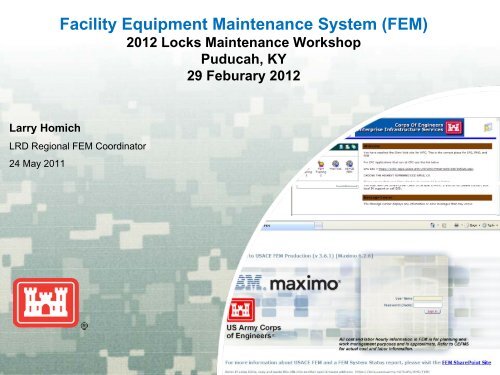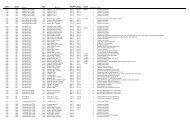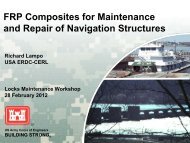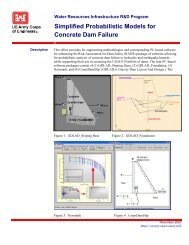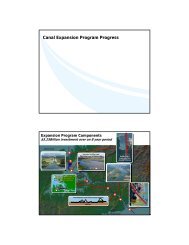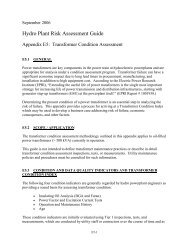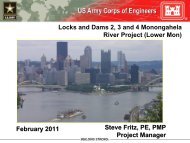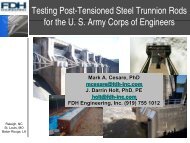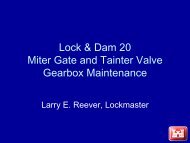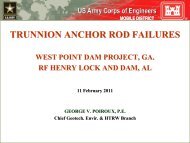Facility Equipment Maintenance System (FEM) - U.S. Army
Facility Equipment Maintenance System (FEM) - U.S. Army
Facility Equipment Maintenance System (FEM) - U.S. Army
You also want an ePaper? Increase the reach of your titles
YUMPU automatically turns print PDFs into web optimized ePapers that Google loves.
<strong>Facility</strong> <strong>Equipment</strong> <strong>Maintenance</strong> <strong>System</strong> (FEM)<br />
2012 Locks <strong>Maintenance</strong> Workshop<br />
Puducah, KY<br />
29 Feburary 2012<br />
Larry Homich<br />
LRD Regional FEM Coordinator<br />
24 May 2011<br />
US <strong>Army</strong> Corps of Engineers<br />
BUILDING STRONG ®
HQs Utilization, <strong>Maintenance</strong><br />
Management Initiative<br />
Goals<br />
Increase reliability<br />
Availability<br />
Operational Effectiveness<br />
<strong>Maintenance</strong> Efficiency
"Run‐to‐failure maintenance"<br />
Corrective <strong>Maintenance</strong><br />
Breakdown maintenance<br />
"Fix it before it breaks"<br />
Preventive <strong>Maintenance</strong><br />
Schedule maintenance<br />
Historical maintenance<br />
Calendar based maintenance<br />
"If it Isn't broke, don't fix it"<br />
Predictive <strong>Maintenance</strong><br />
Condition based maintenance<br />
‐ High risk of secondary failure<br />
‐ High production downtime<br />
‐ Has Overtime Costs<br />
‐ Potential Safety Hazards<br />
‐ Machines are repaired when<br />
there are no faults<br />
‐ Repair often causes more harm<br />
than good<br />
‐ There are still 'unscheduled'<br />
breakdowns<br />
‐ High investment costs<br />
‐ Additional skills required<br />
+ Machines are not 'over maintained'<br />
+ No condition monitoring related<br />
costs<br />
+ <strong>Maintenance</strong> is performed in<br />
controlled manner<br />
+ Fewer catastrophic failures<br />
+ Greater control over stored parts and<br />
costs<br />
+ Unexpected machinery failure should<br />
be reduced<br />
+ Unexpected breakdown is reduced<br />
+ Parts are ordered when needed<br />
+ <strong>Maintenance</strong> is performed when<br />
convenient<br />
+ <strong>Equipment</strong> life is extended<br />
"Fix it at the right time"<br />
Proactive <strong>Maintenance</strong><br />
Prognostic maintenance<br />
Reliability Centered maintenance<br />
Ref: DoD Guidebook “Condition Based <strong>Maintenance</strong> Plus”, May<br />
2008<br />
‐ High investment costs<br />
‐ Additional skills required<br />
‐ Additional time invested upfront<br />
‐ Requires a change in philosophy<br />
from management and down<br />
+ <strong>Equipment</strong> life is extended<br />
+ Reduced downtime<br />
+ Reduced overall maintenance costs<br />
+ Improved equipment reliability<br />
+ Fewer failures, thus fewer secondary<br />
failures
Review of FEM<br />
BUILDING STRONG ®
LRD FEM Status Overview<br />
• The last LRD District that received initial<br />
FEM Training was 22 months ago, earliest<br />
was 32 months ago<br />
• ~167,000 Work Orders, 95.1% are Routine<br />
BUILDING STRONG ®
Labor<br />
Money<br />
Environmental<br />
Process
3.1 FEM utilization milestones (reference LRD FEM PgMP, 10 October 2010)<br />
The following schedule applies to all business lines and repair parties in FEM:<br />
For non-routine maintenance, within 1 year of deployment of FEM:<br />
For all non-routine work orders, the Local Work Type will be selected that represents the<br />
purpose of the Work Order.<br />
Use of failure reporting is required on all work orders.<br />
While non-routine work orders will vary in terms of time to completion or repair,<br />
it is expected that actual labor and material data will be recorded upon close-out of the nonroutine<br />
work order.<br />
For routine maintenance, within 2 years of FEM deployment:<br />
All job plans and PMs will be created and logged.<br />
All work orders should be completed after 120 days<br />
The closed work order should include recorded, actual labor and material data<br />
Within 3 years after the deployment of FEM, the asset hierarchy in FEM must align with the<br />
OCA effort for all assets with a condition code of C, D or F. Furthermore, assets with C, D or F<br />
condition codes must also have a correlating non-routine work order as well. Lastly, whenever<br />
OCA condition codes change FEM must be updated to reflect such changes.<br />
Within 5 years after the deployment of FEM, districts will canvas and identify historical<br />
maintenance records for replaced/repaired critical assets (critical assets are identified in<br />
Appendix H) and create a FEM non-routine work order for those assets. This action will assist<br />
risk and reliability activities for OCA.
Repair Station Non Routine Work Orders
Work Order: Replacement Nut End Tension Bar
Copy Paste Example of Work Detail in Work Order
Graph Showing All Repair Party Work Orders by Location
Current Efforts<br />
• QA/QC – Job Plans, Preventive<br />
<strong>Maintenance</strong> Plans, Work Orders that are<br />
in FEM<br />
• Fleet and Repair Station: Review/Build<br />
Asset Hierarchy, Job and Preventive<br />
<strong>Maintenance</strong> Plans<br />
• Process for Inspections<br />
• Build relationship between OCA and FEM<br />
BUILDING STRONG ®
BUILDING STRONG ®
LRD FEM PDT Members<br />
BUILDING STRONG ®
Make FEM work for U<br />
BUILDING STRONG ®
Questions<br />
• National FEM Support SharePoint Website -<br />
https://kme.usace.army.mil/CoPs/AMC/FEM/default.aspx<br />
Status of FEM database<br />
Library of FEM Manuals<br />
Links to FEM Production (Internet and Citrix) and<br />
Training Database (Citrix)<br />
• LRD FEM SharePoint Website –<br />
https://kme.usace.army.mil/LRD/FEM/default.aspx<br />
LRD FEM PgMP, updates, links.<br />
BUILDING STRONG ®


